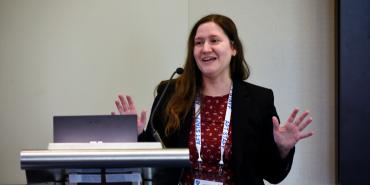Community schools are comprehensive, democratic institutions. Built on partnerships, they connect teaching and learning to community development and problem-solving. These neighborhood centers serve the educational, social service, health and recreational needs that are crucial for student success, contributing to both improved student learning and increased community well-being. As such, they are one of the five essential strategies in the AFT’s new Real Solutions for Kids and Communities campaign.
Attendees at the AFT TEACH workshop “Community Schools: Organizing for What Kids Need” were asked about the ideas and buzzwords they connected with community schools. They suggested partnership, holistic, responsive, critical, equity, giving kids what they need where they’re at, and AFT. Presenter Dena Donaldson, an assistant director in the AFT’s Educational Issues Department, emphasized that while community schools’ programs and services meet critical community needs, they are much more than what they provide—and unions play an important role in moving them forward.
She gave an overview of the community schools strategy, including the core principles and characteristics and the essential components for successful implementation. But the key when thinking about forming a community school, she said, is getting the right people involved. “In sustainable community schools, stakeholders are empowered to be partners, contributors and leaders,” Donaldson said. “If you build the relationships that strengthen people in those roles, you’ll create a transformational system where everyone is creating solutions together to meet the community’s needs. This requires a lot of organizing.”
Community schools are a great organizing tool because they can bring people together, and unions are uniquely positioned to leverage the relational power and engagement necessary to implement and ensure fidelity to the model. Donaldson shared that the goals of community school organizing include cultivating deep buy-in and support from the community, emphasizing collaborative leadership and shared decision-making, and ensuring that community schools are sustainable in the long term. Depending on their capacity, unions can also be a lead agency in forming and implementing community schools, leveraging labor-management partnerships, choosing or hiring site coordinators, and pushing for transparency in how schools are formed and implemented.
No matter where attendees were in their journeys, Donaldson assured them that the AFT can help and will provide resources, including case studies of successful community school initiatives and the AFT’s course on community school campaign planning.
AFT Executive Vice President Evelyn DeJesus, who attended the session, encouraged everyone to visit aft.org/position/community-schools for more resources and shared that the AFT’s community schools initiative is personal for her. “I grew up in a tough neighborhood,” she said. “Community schools saved my life and my children’s lives.” And as a member of President Biden’s Advisory Commission on Advancing Educational Equity, Excellence, and Economic Opportunity for Hispanics, she is the chair of the preK-12 committee—and the top issue is expanding community schools across the country.
Rallying the audience, DeJesus said, “All the stars have aligned. We have people in the White House advising the president of the United States of America, and he’s listening… . So, I’m just letting you know that not only is the AFT at the table, but we’re redesigning the table. We hear you, and we’re going to make this happen.”
[Lesley Gonzalez]

